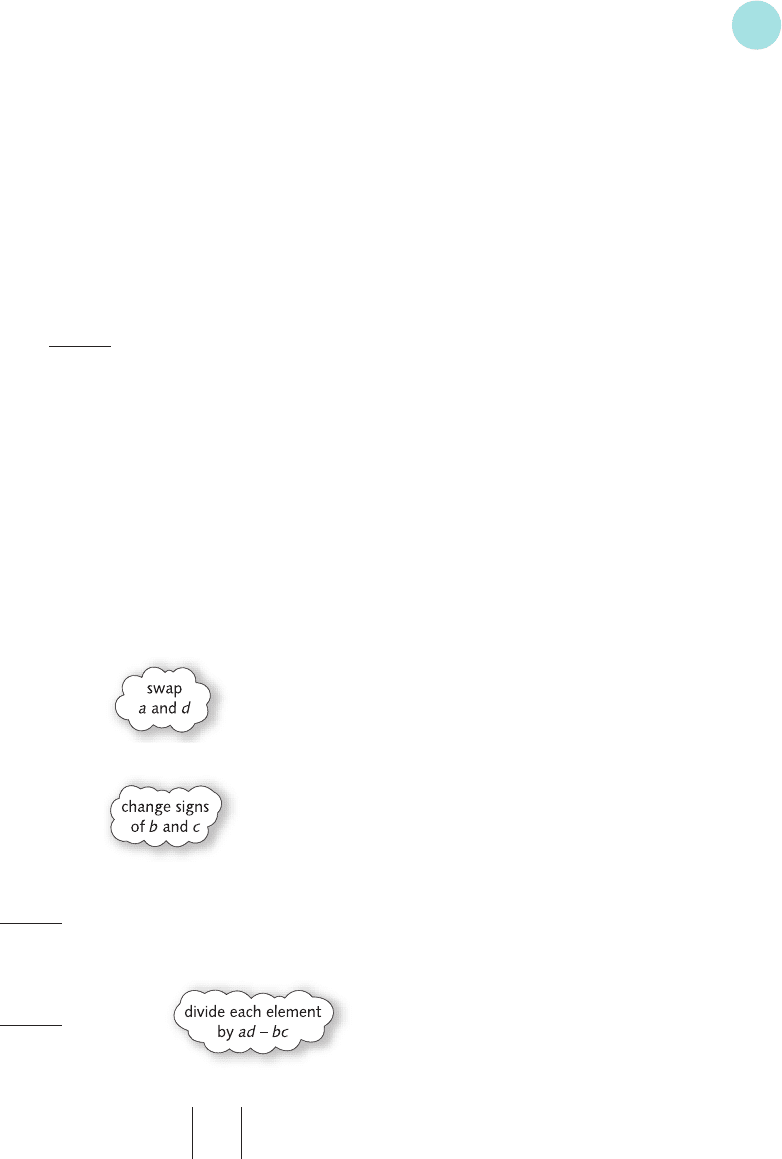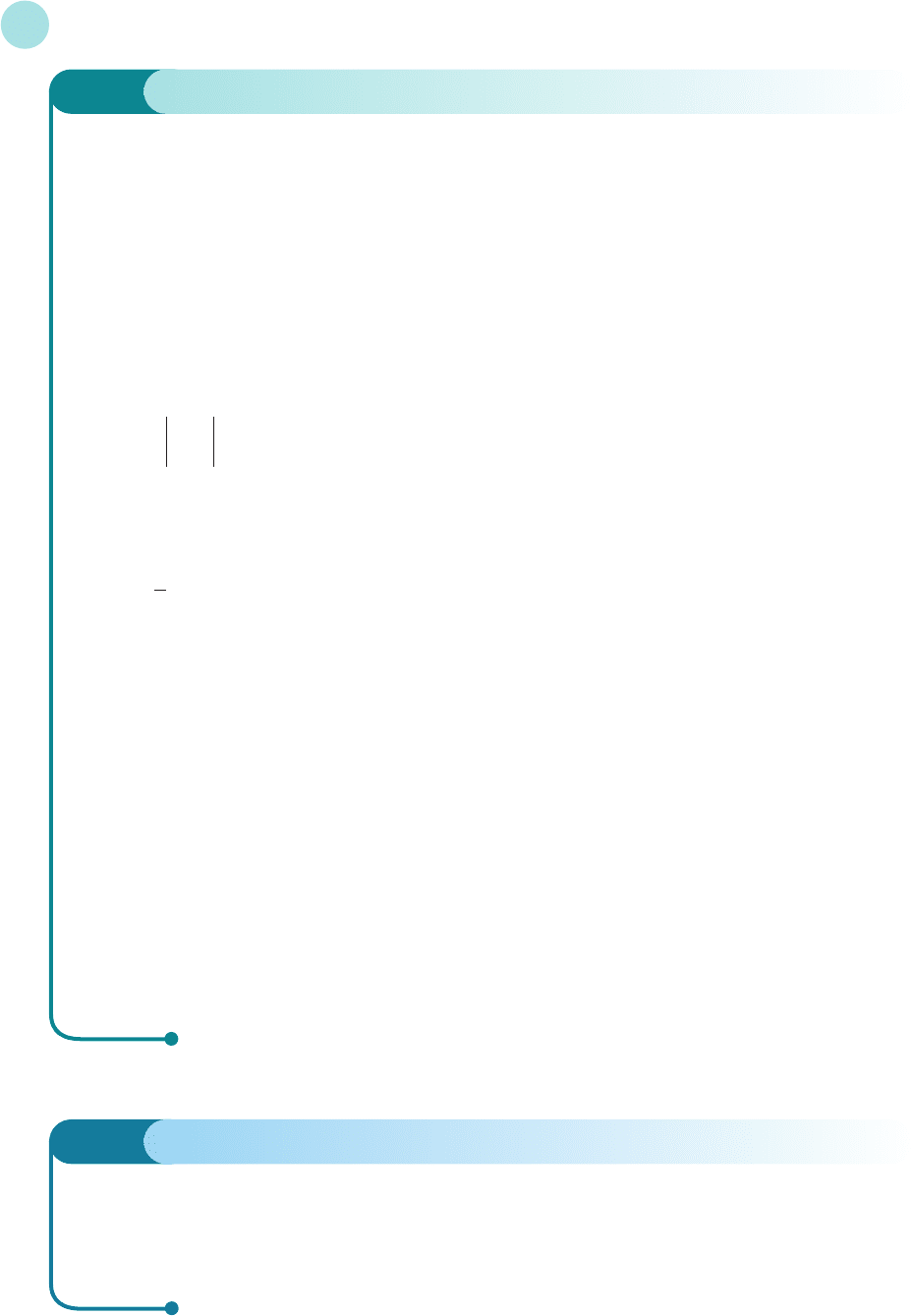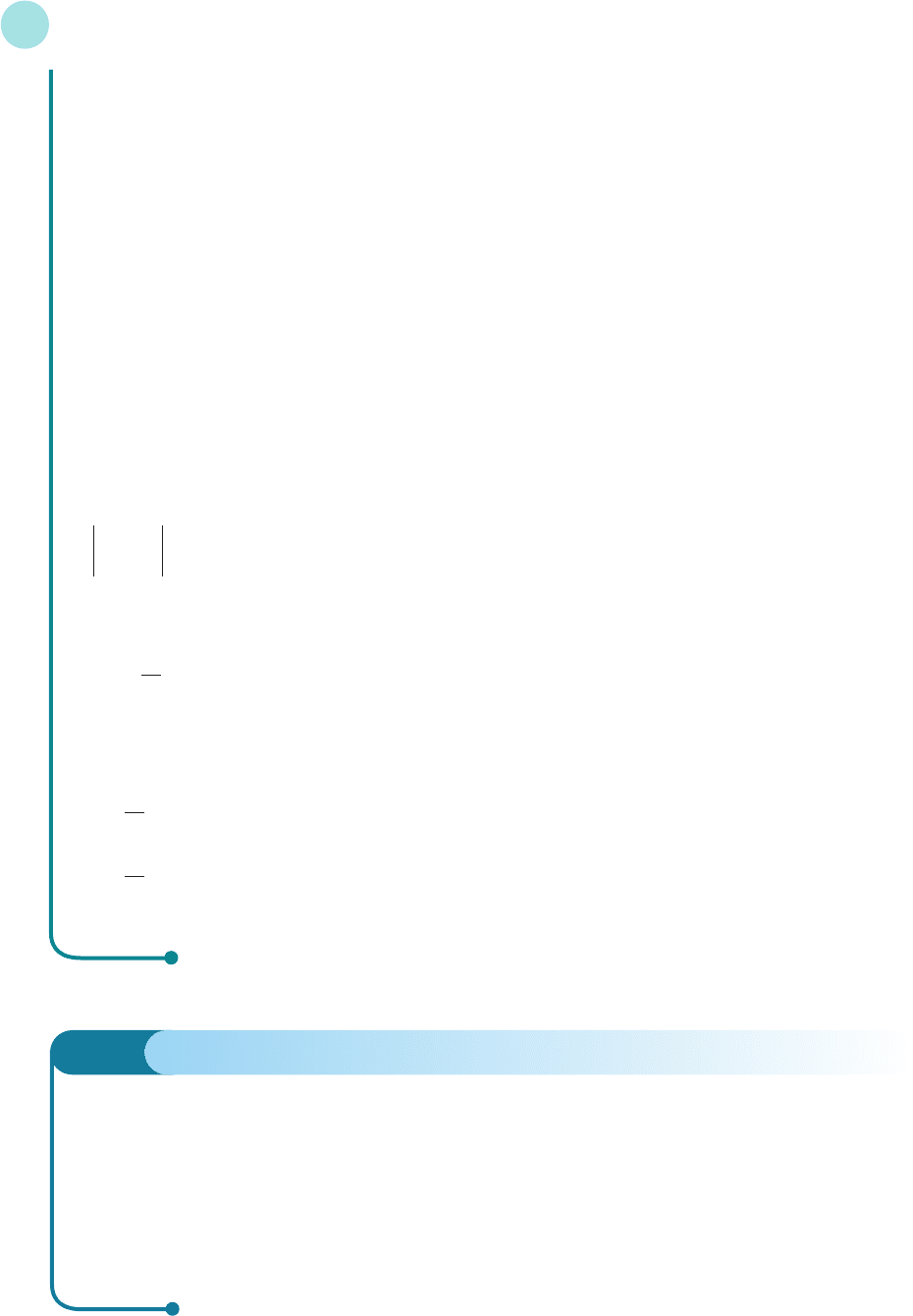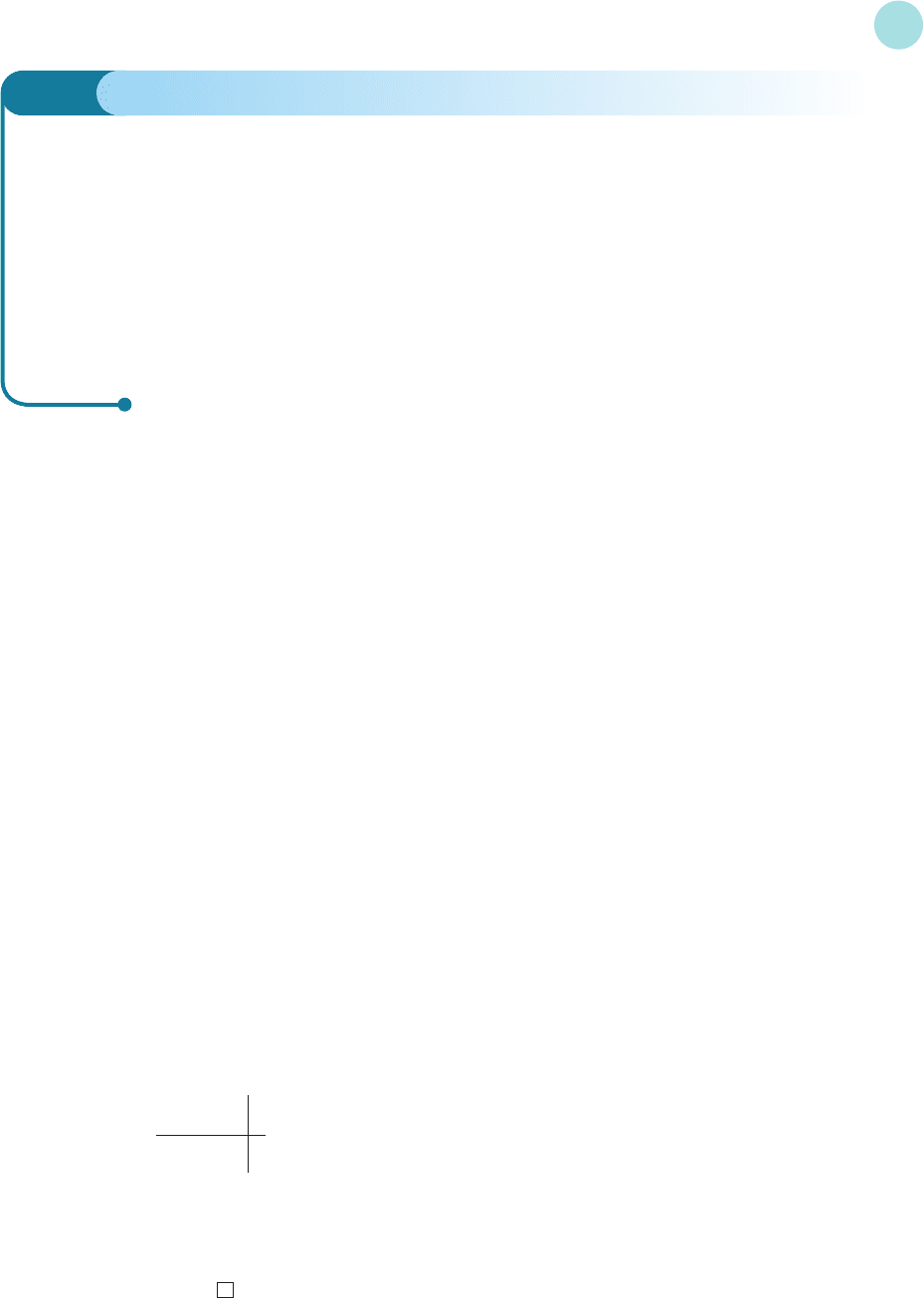Jacques I. Mathematics for Economics and Business
Подождите немного. Документ загружается.


The firm charges both customers the same price for each product according to
P1 P2 P3
B = [100 500 200]
T
To make each item of type P1, P2 and P3, the firm uses four raw materials, R1, R2, R3 and R4. The
number of tonnes required per item is given by
R1 R2 R3 R4
C = P1
P2
P3
The cost per tonne of raw materials is
R1 R2 R3 R4
D = [20 10 15 15]
T
In addition, let
E = [1 1]
Find the following matrix products and give an interpretation of each one.
(a)
AB (b) AC (c) CD (d) ACD (e) EAB
(f) EACD (g) EAB − EACD
12 (1) Let
A = and B =
Find
(a)
A
T
(b) B
T
(c) A + B (d) (A + B)
T
Do you notice any connection between (A + B)
T
, A
T
and B
T
?
(2) Let
C = and D =
Find
(a)
C
T
(b) D
T
(c) CD (d) (CD)
T
Do you notice any connection between (CD)
T
, C
T
and D
T
?
13 Verify the equations
(a)
A(B + C) = AB + AC (b) (AB)C
==
A(BC)
in the case when
A = , B = and C =
J
K
L
−11
12
G
H
I
J
K
L
15
40
G
H
I
J
K
L
5 −3
21
G
H
I
J
K
L
210
−101
G
H
I
J
K
L
14
59
G
H
I
J
K
K
L
1 −1
21
−34
G
H
H
I
J
K
K
L
12
34
56
G
H
H
I
J
K
K
L
1001
1121
0011
G
H
H
I
Matrices
470
MFE_C07a.qxd 16/12/2005 10:45 Page 470

14 If
A = [1 2 −43]andB =
find AB and BA.
15 Let
A = , A
−1
= (ad − bc ≠ 0)
I = and x =
Show that
(a)
AI = A and IA = A (b) A
−1
A = I and AA
−1
= I (c) Ix = x
16
(a) Evaluate the matrix product, Ax, where
A = and x =
Hence show that the system of linear equations
7x + 5y = 3
x + 3y = 2
can be written as Ax = b where b = .
(b) The system of equations
2x + 3y − 2z = 6
x − y + 2z = 3
4x + 2y + 5z = 1
can be expressed in the form Ax = b. Write down the matrices A, x and b.
J
K
L
3
2
G
H
I
J
K
L
x
y
G
H
I
J
K
L
75
13
G
H
I
J
K
L
x
y
G
H
I
J
K
L
10
01
G
H
I
J
K
L
d −b
−ca
G
H
I
1
ad − bc
J
K
L
ab
cd
G
H
I
J
K
K
K
K
L
1
7
3
−2
G
H
H
H
H
I
7.1 • Basic matrix operations
471
MFE_C07a.qxd 16/12/2005 10:45 Page 471

section 7.2
Matrix inversion
In this and the following section we consider square matrices, in which the number of rows and
columns are equal. For simplicity we concentrate on 2 × 2 and 3 × 3 matrices, although the
ideas and techniques apply more generally to n × n matrices of any size. We have already seen
that, with one notable exception, the algebra of matrices is virtually the same as the algebra
of numbers. There are, however, two important properties of numbers which we have yet to
consider. The first is the existence of a number, 1, which satisfies
a1 = a and 1a = a
for any number, a. The second is the fact that corresponding to any non-zero number, a, we
can find another number, a
−1
, with the property that
a
−1
a = 1 and aa
−1
= 1
If you have worked through Practice Problem 15 of Section 7.1 you will know how to extend
these to 2 × 2 matrices. In part (a) you showed that, for any 2 × 2 matrix, A,
AI = A and IA = A
Objectives
At the end of this section you should be able to:
Write down the 2 × 2 and 3 × 3 identity matrices.
Detect whether a matrix is singular or non-singular.
Calculate the determinant and inverse of a 2 × 2 matrix.
Calculate the cofactors of a 3 × 3 matrix.
Use cofactors to find the determinant and inverse of a 3 × 3 matrix.
Use matrix inverses to solve systems of linear equations arising in economics.
MFE_C07b.qxd 16/12/2005 10:45 Page 472

where
I =
The matrix I is called the identity matrix and is analogous to the number 1 in ordinary arith-
metic. You also showed in part (b) of Practice Problem 15 that corresponding to the 2 × 2 matrix
A =
there is another matrix
A
−1
=
with the property that
A
−1
A = I and AA
−1
= I
The matrix A
−1
is said to be the inverse of A and is analogous to the reciprocal of a number.
The formula for A
−1
looks rather complicated but the construction of A
−1
is in fact very easy.
Starting with some matrix
A =
we first swap the two numbers on the leading diagonal (that is, the elements along the line join-
ing the top left-hand corner to the bottom right-hand corner of A) to get
Secondly, we change the sign of the ‘off-diagonal’ elements to get
Finally, we multiply the matrix by the scalar
to get
The number ad − bc is called the determinant of A and is written as
det(A)or|A| or
Notice that the last step in the calculation is impossible if
|A |=0
because we cannot divide by zero. We deduce that the inverse of a matrix exists only if the
matrix has a non-zero determinant. This is comparable to the situation in arithmetic where a
reciprocal of a number exists provided the number is non-zero. If the matrix has a non-zero
determinant, it is said to be non-singular; otherwise it is said to be singular.
ab
cd
J
K
L
d −b
−
ca
G
H
I
1
ad − bc
1
ad − bc
J
K
L
d −b
−
ca
G
H
I
J
K
L
db
ca
G
H
I
J
K
L
ab
cd
G
H
I
J
K
L
d −b
−
ca
G
H
I
1
ad − bc
J
K
L
ab
cd
G
H
I
J
K
L
10
01
G
H
I
7.2 • Matrix inversion
473
MFE_C07b.qxd 16/12/2005 10:45 Page 473

Matrices
474
Example
Find the inverse of the following matrices. Are these matrices singular or non-singular?
A = and B =
Solution
We begin by calculating the determinant of
A =
to see whether or not the inverse exists.
det(A) ==1(4) − 2(3) = 4 − 6 =−2
We see that det(A) ≠ 0, so the matrix is non-singular and the inverse exists. To find A
−1
we swap the diag-
onal elements, 1 and 4, change the sign of the off-diagonal elements, 2 and 3, and divide by the determinant,
−2. Hence
A
−1
=− =
Of course, if A
−1
really is the inverse of A, then A
−1
A and AA
−1
should multiply out to give I. As a check:
A
−1
A ==✓
AA
−1
==✓
To discover whether or not the matrix
B =
has an inverse we need to find its determinant.
det(B) ==2(10) − 5(4) = 20 − 20 = 0
We see that det(B) = 0, so this matrix is singular and the inverse does not exist.
J
K
L
25
410
G
H
I
J
K
L
25
410
G
H
I
J
K
L
10
01
G
H
I
J
K
L
−21
3/2 −1/2
G
H
I
J
K
L
12
34
G
H
I
J
K
L
10
01
G
H
I
J
K
L
12
34
G
H
I
J
K
L
−21
3/2 −1/2
G
H
I
J
K
L
−21
3/2 −1/2
G
H
I
J
K
L
4 −2
−31
G
H
I
1
2
12
34
J
K
L
12
34
G
H
I
J
K
L
25
410
G
H
I
J
K
L
12
34
G
H
I
Practice Problem
1 Find (where possible) the inverse of the following matrices. Are these matrices singular or non-
singular?
A = B =
J
K
L
64
32
G
H
I
J
K
L
64
12
G
H
I
MFE_C07b.qxd 16/12/2005 10:45 Page 474

7.2 • Matrix inversion
475
One reason for calculating the inverse of a matrix is that it helps us to solve matrix equations
in the same way that the reciprocal of a number is used to solve algebraic equations. We have
already seen in Section 7.1 how to express a system of linear equations in matrix form. Any
2 × 2 system
ax + by = e
cx + dy = f
can be written as
Ax = b
where
A = x = b =
The coefficient matrix, A, and right-hand-side vector, b, are assumed to be given and the prob-
lem is to determine the vector of unknowns, x. Multiplying both sides of
Ax = b
by A
−1
gives
A
−1
(Ax) = A
−1
b
(A
−1
A)x = A
−1
b (associative property)
Ix = A
−1
b (definition of an inverse)
x = A
−1
b (Practice Problem 15(c) in Section 7.1)
The solution vector x can therefore be found simply by multiplying A
−1
by b. We are assuming
here that A
−1
exists. If the coefficient matrix is singular then the inverse cannot be found and
the system of linear equations does not possess a unique solution; there are either infinitely
many solutions or no solution.
J
K
L
e
f
G
H
I
J
K
L
x
y
G
H
I
J
K
L
ab
cd
G
H
I
Advice
These special cases are dealt with using the elimination method described in Section 1.2.
You might find it instructive to revise both Sections 1.2 and 1.3.
The following two examples illustrate the use of inverses to solve systems of linear equations.
The first is taken from microeconomics and the second from macroeconomics.
Example
The equilibrium prices P
1
and P
2
for two goods satisfy the equations
−4P
1
+ P
2
=−13
2P
1
− 5P
2
=−7
Express this system in matrix form and hence find the values of P
1
and P
2
.
MFE_C07b.qxd 16/12/2005 10:45 Page 475

Matrices
476
Solution
Using the notation of matrices, the simultaneous equations
−4P
1
+ P
2
=−13
2P
1
− 5P
2
=−7
can be written as
=
that is, as
Ax = b
where
A = x = b =
The matrix A has determinant
= (−4)(−5) − (1)(2) = 20 − 2 = 18
To find A
−1
we swap the diagonal elements, −4 and −5, change the sign of the off-diagonal elements, 1 and
2, and divide by the determinant, 18, to get
A
−1
=
Finally, to calculate x we multiply A
−1
by b to get
x = A
−1
b
=
==
Hence P
1
= 4 and P
2
= 3.
J
K
L
4
3
G
H
I
J
K
L
72
54
G
H
I
1
18
J
K
L
−13
−7
G
H
I
J
K
L
−5 −1
−2 −4
G
H
I
1
18
J
K
L
−5 −1
−2 −4
G
H
I
1
18
−41
2 −5
J
K
L
−13
−7
G
H
I
J
K
L
P
1
P
2
G
H
I
J
K
L
−41
2 −5
G
H
I
J
K
L
−13
−7
G
H
I
J
K
L
P
1
P
2
G
H
I
J
K
L
−41
2 −5
G
H
I
Practice Problem
2 The equilibrium prices P
1
and P
2
for two goods satisfy the equations
9P
1
+ P
2
= 43
2P
1
+ 7P
2
= 57
Express this system in matrix form and hence find the values of P
1
and P
2
.
[You have already solved this particular system in Practice Problem 4 of Section 1.3. You might like
to compare the work involved in solving this system using the method of elimination described in
Chapter 1 and the method based on matrix inverses considered here.]
MFE_C07b.qxd 16/12/2005 10:45 Page 476

7.2 • Matrix inversion
477
Example
The equilibrium levels of consumption, C, and income, Y, for the simple two-sector macro-economic model
satisfy the structural equations
Y = C + I*
C = aY + b
where a and b are parameters in the range 0 < a < 1 and b > 0, and I* denotes investment. Express this sys-
tem in matrix form and hence express Y and C in terms of a, b and I*. Give an economic interpretation of
the inverse matrix.
Solution
The reduced form of the structural equations for this simple model has already been found in Section 5.3.
It is instructive to reconsider this problem using matrices. The objective is to express the endogenous vari-
ables, Y and C, in terms of the exogenous variable I* and parameters a and b. The ‘unknowns’ of this prob-
lem are therefore Y and C, and we begin by rearranging the structural equations so that these variables
appear on the left-hand sides. Subtracting C from both sides of
Y = C + I*
gives
Y − C = I* (1)
and if we subtract aY from both sides of
C = aY + b
we get
−aY + C = b (2)
(It is convenient to put the term involving Y first so that the variables align with those of equation (1).)
In matrix form, equations (1) and (2) become
=
that is,
Ax = b
where
A = x = b =
The matrix A has determinant
= 1(1) − (−1)(−a) = 1 − a
which is non-zero because a < 1.
To find A
−1
, we swap the diagonal elements, 1 and 1, change the sign of the off-diagonal elements, −1 and
−a, and divide by the determinant, 1 − a, to get
A
−1
=
J
K
L
11
a 1
G
H
I
1
1 − a
1 −1
−a 1
J
K
L
I*
b
G
H
I
J
K
L
Y
C
G
H
I
J
K
L
1 −1
−a 1
G
H
I
J
K
L
I*
b
G
H
I
J
K
L
Y
C
G
H
I
J
K
L
1 −1
−a 1
G
H
I
MFE_C07b.qxd 16/12/2005 10:45 Page 477

Matrices
478
Finally, to determine x we multiply A
−1
by b to get
x = A
−1
b
==
Hence
Y = and C =
The inverse matrix obviously provides a useful way of solving the structural equations of a macroeconomic
model. In addition, the elements of the inverse matrix can be given an important economic interpretation.
To see this, let us suppose that the investment I* changes by an amount ∆I* to become I* +∆I*, with the
parameter b held fixed. The new values of Y and C are obtained by replacing I* by I* +∆I* in the expres-
sions for Y and C, and are given by
and
respectively. The change in the value of Y is therefore
∆Y =−=∆I*
and the change in the value of C is
∆C =−=∆I*
In other words, the changes to Y and C are found by multiplying the change in I* by
and
respectively. For this reason we call
the investment multiplier for Y and
the investment multiplier for C.
Now the inverse matrix is
A
−1
=
and we see that these multipliers are precisely the elements that appear in the first column. It is easy to show,
using a similar argument, that the second column contains the multipliers for Y and C due to changes in the
autonomous consumption, b. The four elements in the inverse matrix can thus be interpreted as follows:
I* b
Y
C
J
K
L
investment multiplier for Y autonomous consumption multiplier for Y
investment multiplier for C autonomous consumption multiplier for C
G
H
I
J
K
K
K
K
L
11
1 − a 1 − a
a 1
1 − a 1 − a
G
H
H
H
H
I
a
1 − a
1
1 − a
a
1 − a
1
1 − a
D
F
a
1 − a
A
C
aI* + b
1 − a
a(I* +∆I *) + b
1 − a
D
F
1
1 − a
A
C
I* + b
1 − a
I* +∆I * + b
1 − a
a(I* +∆I *) + b
1 − a
I* +∆I* + b
1 − a
aI* + b
1 − a
I* + b
1 − a
J
K
L
I* + b
aI* + b
G
H
I
1
1 − a
J
K
L
I*
b
G
H
I
J
K
L
11
a 1
G
H
I
1
1 − a
MFE_C07b.qxd 16/12/2005 10:45 Page 478

7.2 • Matrix inversion
479
The concepts of determinant, inverse and identity matrices apply equally well to 3 × 3 matrices.
The identity matrix is easily dealt with. It can be shown that the 3 × 3 identity matrix is
I =
You are invited to check that, for any 3 × 3 matrix A,
AI = A and IA = A
Before we can discuss the determinant and inverse of a 3 × 3 matrix we need to introduce an
additional concept known as a cofactor. Corresponding to each element a
ij
of a matrix A, there
is a cofactor, A
ij
. A 3 × 3 matrix has nine elements, so there are nine cofactors to be computed.
The cofactor, A
ij
, is defined to be the determinant of the 2 × 2 matrix obtained by deleting row
i and column j of A, prefixed by a ‘+’ or ‘−’ sign according to the following pattern
For example, suppose we wish to calculate A
23
, which is the cofactor associated with a
23
in the matrix
A =
The element a
23
lies in the second row and third column. Consequently, we delete the second
row and third column to produce the 2 × 2 matrix
The cofactor, A
23
, is the determinant of this 2 × 2 matrix prefixed by a ‘−’ sign because from the
pattern
J
K
K
L
+−+
−+−
+−+
G
H
H
I
J
K
K
L
a
11
a
12
a
13
a
21
a
22
a
23
a
31
a
32
a
33
G
H
H
I
J
K
K
L
a
11
a
12
a
13
a
21
a
22
a
23
a
31
a
32
a
33
G
H
H
I
J
K
K
L
+−+
−+−
+−+
G
H
H
I
J
K
K
L
100
010
001
G
H
H
I
Practice Problem
3 The general linear supply and demand equations for a one-commodity market model are given by
P = aQ
S
+ b (a > 0, b > 0)
P =−cQ
D
+ d (c > 0, d > 0)
Show that in matrix notation the equilibrium price, P, and quantity, Q, satisfy
=
Solve this system to express P and Q in terms of a, b, c and d. Write down the multiplier for Q due to
changes in b and deduce that an increase in b leads to a decrease in Q.
J
K
L
b
d
G
H
I
J
K
L
P
Q
G
H
I
J
K
L
1 −a
1 c
G
H
I
MFE_C07b.qxd 16/12/2005 10:45 Page 479
